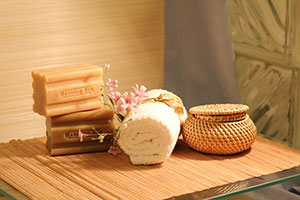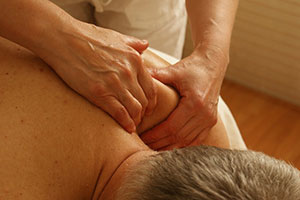Reflexology Targeting Body Systems Through the Feet

Targeting Body Systems With Reflexology
Reflexology is an ancient practice that has been around for thousands of years. Rooted in the belief that different pressure points on our feet correspond to various organs and body systems, reflexology is a non-invasive therapy that aims to promote overall well-being and balance. Utilizing specific techniques and pressure applications, reflexologists seek to stimulate these points on the feet, potentially leading to improved health and relaxation.
In this article, we'll delve deeper into the foundations of reflexology, exploring the connections between pressure points and their corresponding organs. Furthermore, we will discuss the techniques employed by reflexologists and the potential health benefits one might experience from this holistic therapy. Lastly, we'll provide some tips for those interested in trying reflexology at home, making it easier than ever to experience the benefits of this ancient practice. So kick off your shoes and get ready to learn how reflexology might just be the key to unlocking improved health and well-being through your feet.
The Foundations of Reflexology
You might be surprised to know that the foundations of reflexology lie in the belief that your feet can be the key to unlocking better health for your entire body's systems. This ancient practice, which has roots in China and Egypt, has been used for thousands of years to promote balance and harmony within the body. Reflexology is based on the concept that your feet contain a map of your entire body, with specific points on the feet corresponding to different organs and systems. By applying pressure to these points, a reflexologist can stimulate the body's natural healing abilities and improve overall well-being.
Reflexology practitioners use their hands, fingers, and sometimes tools to apply pressure to these specific points on the feet. This pressure can help to improve blood flow, reduce stress, and alleviate pain in the corresponding body systems. The practice is often used as a complementary therapy alongside conventional medical treatments to enhance their effectiveness and provide a holistic approach to health care. As more people seek alternative methods to support their health and well-being, reflexology continues to gain popularity as a natural, non-invasive way to target the body's systems through the feet.
Pressure Points and Corresponding Organs
By applying pressure to specific points on your feet, it's possible to stimulate and support various organs and systems within your body. This concept is based on the belief that certain areas of the feet, known as reflex points, correspond to specific organs, glands, and other parts of the body. By massaging these points, reflexologists aim to improve the overall health and functioning of these corresponding organs and systems, thus promoting balance and well-being in the body.
For example, the tips of the toes are said to be connected to the head and sinuses, while the ball of the foot is believed to be linked to the heart and chest. Similarly, the arch of the foot is associated with the liver, pancreas, and kidneys, and the heel corresponds to the lower back and intestines. By targeting these specific pressure points, reflexologists can potentially alleviate symptoms related to various health concerns, such as headaches, digestive issues, and respiratory problems, as well as promote relaxation and stress relief. However, it's important to note that reflexology should not be used as a sole treatment for any medical condition but can be a helpful complementary therapy alongside conventional treatments.
Techniques Used by Reflexologists
In order to stimulate various organs and promote overall well-being, reflexologists utilize a variety of techniques when working on the feet's pressure points. One common method is called the thumb walking technique, in which the reflexologist applies pressure using the outer edge of their thumb, slowly "walking"it along the foot, pressing and releasing at specific points. Another technique is finger walking, which is similar to thumb walking but utilizes the fingers instead. Reflexologists may also employ the hook and back-up method, where they use their fingers to hook onto a pressure point and then apply pressure in a backward motion to stimulate the corresponding organ or body system.
Another essential technique used by reflexologists is the rotation on a point method. In this approach, the practitioner holds a specific pressure point with their thumb or finger and then rotates it in a circular motion, either clockwise or counterclockwise, to stimulate the corresponding area of the body. This technique can be particularly useful for releasing tension and promoting relaxation. Additionally, reflexologists may use massage techniques, such as kneading and effleurage, to warm up the feet and enhance circulation before focusing on specific pressure points. By employing these various techniques, reflexologists aim to restore balance and promote optimal health throughout the body.
Potential Health Benefits
It's truly astounding how stimulating specific pressure points on the feet can lead to a plethora of potential health benefits, from stress relief to improved circulation and beyond. Reflexology is believed to help balance the body's energy flow, which in turn can promote self-healing and overall well-being. Some of the potential benefits include reduced anxiety and depression, improved sleep quality, and relief from headaches and migraines. Additionally, reflexology may help alleviate symptoms related to chronic conditions such as arthritis, asthma, and digestive disorders.
Another key benefit of reflexology is its ability to boost circulation throughout the body, which can lead to increased oxygen and nutrient delivery to cells and improved waste removal. This improved circulation can in turn contribute to enhanced immune function, promoting faster recovery from illness and injury as well as preventing future health issues. Furthermore, reflexology has been known to help with pain management, as it promotes the release of endorphins, the body's natural painkillers. Overall, reflexology targeting body systems through the feet offers a non-invasive, holistic approach to improving one's health and well-being.
Tips for Trying Reflexology at Home
Imagine the relief and relaxation you'll experience as you try reflexology techniques in the comfort of your own home, taking charge of your well-being and promoting self-healing. To get started, familiarize yourself with a reflexology foot chart, which illustrates the specific areas of the feet that correspond to different body systems and organs. Invest in a reflexology stick, roller, or massage ball designed specifically for targeting these pressure points. Begin by soaking your feet in warm water to relax the muscles and joints, then gently massage each foot with oil or lotion to increase circulation and prepare for the reflexology session.
When practicing reflexology at home, always start with a gentle touch and gradually increase pressure as needed. Press and hold each pressure point for a few seconds, then release and move on to the next point. Work your way through each foot, paying special attention to any areas that feel tender or painful, as this may indicate an imbalance or issue within the corresponding body system. As you become more proficient in reflexology, you can customize your sessions to target specific concerns or ailments, such as digestive issues, headaches, or stress relief. Remember to be patient and consistent with your practice, as the benefits of reflexology may take time to manifest and vary from person to person.
Frequently Asked Questions
What are the contraindications or potential risks associated with reflexology treatments?
Contraindications or risks with reflexology treatments include blood clot risk, infection, or injury exacerbation. Pregnant women, individuals with foot injuries, or those with circulatory disorders should consult a professional before treatment.How long does a typical reflexology session last, and how many sessions are recommended for optimal results?
A typical reflexology session lasts around 45-60 minutes, and the recommended number of sessions varies depending on individual needs. Some may experience relief after one session, while others may require multiple treatments.Can reflexology be used in conjunction with other alternative therapies or conventional medical treatments?
Yes, reflexology can be used alongside other alternative therapies and conventional medical treatments. It is often combined with treatments like acupuncture, aromatherapy, and massage therapy to enhance overall wellness and healing.Are there any specific qualifications or certifications required for someone to practice reflexology professionally?
Yes, qualifications and certifications are typically required to practice reflexology professionally. Requirements vary by location, but generally include completing a recognized course and obtaining certification from a professional organization.How does reflexology compare in terms of effectiveness and safety to other forms of alternative medicine, such as acupuncture or chiropractic care?
Reflexology, acupuncture, and chiropractic care are alternative therapies with varying degrees of evidence supporting their effectiveness. Overall, reflexology is considered safe but its effectiveness compared to other therapies remains inconclusive.
Conclusion
In conclusion, reflexology's a fascinating practice that targets various body systems through the feet. By applying pressure to specific points, it's believed to help promote overall wellness and address health concerns.
If you're curious about reflexology, it's worth giving it a try, whether through a professional therapist or attempting some techniques at home. Just remember, it shouldn't replace conventional medical treatment, but it might be a beneficial addition to your self-care routine.




